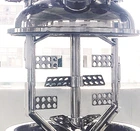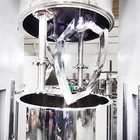Integrating development, manufacturing and sales, as a first-level mixer emulsifier factory.
How to Scale Up from Lab to Production: A Guide to Industrial Mixing Equipment
Deciding to upgrade to larger-scale production means you're expecting to produce more — and with that comes more complexity. Without a clear plan, the transition can be stressful. That’s why we’ve broken down the key steps to help you make this move as smoothly and successful as possible, both for your company and your team.
1. Understand the Lab Process First
Before scaling up, you need a thorough understanding of your current lab-scale process:
- What are the key steps (mixing, heating, emulsifying, etc.)?
- What are the critical parameters (mixing speed, temperature, time)?
- What product qualities do you want to replicate (texture, stability, viscosity)?
Be sure to document everything — even minor variations can become significant at scale. Larger machines offer greater efficiency but may function differently than your lab equipment, so knowing your baseline is crucial.
2. Define Your Scale-Up Goals
Ask yourself: What are we scaling for?
- Higher output?
- Faster production time?
- More consistent product quality?
Your goals should be realistic, measurable, and aligned with future production plans. Define acceptable ranges for changes like batch size, RPM, or mixing time — these will directly impact the machine you choose.
Think long-term: selecting a machine that can't accommodate your future product lines could be a costly mistake. Early collaboration with stakeholders is essential to avoid missteps.
3. Choose the Right Industrial Equipment
Scaling up isn’t just about using a larger mixer — it’s about choosing the right technology to meet your needs. Depending on your product, you might consider:
- Vacuum Emulsifying Mixers for creams, ointments, emulsions
- Planetary Mixers for thick or high-viscosity materials
- homogenizers for particle size reduction and emulsion stability
Key features to evaluate:
- Type of agitation (high shear, scraper, slow-speed)
- Heating and cooling systems
- Vacuum functionality (to remove air bubbles)
- Material (usually 304 or 316L stainless steel)
- Automation and PLC control systems
Start with the product in mind and consult your supplier to ensure the machine meets all technical requirements.
4. Understand Mixing Dynamics
Mixing doesn’t scale linearly. Larger volumes bring new challenges:
- Shear forces behave differently
- Heat transfer may be less efficient
- Flow patterns can change, increasing the risk of dead zones or inconsistent mixing
You may need to adjust your process, including mixing time, speed, or the sequence of ingredient addition.
5. Run Pilot Trials
Before launching full-scale production, test your process on a pilot-scale machine. This step helps you:
- Validate product consistency
- Fine-tune process parameters
- Evaluate equipment performance
While it may seem like a waste of product or time, pilot testing is essential to ensure a successful scale-up.
6. Prepare for Production: SOPs & Quality Checks
Once your process is finalized:
- Develop clear Standard Operating Procedures (SOPs)
- Train your team on both operation and safety (especially any machine-specific steps)
- Set up quality control checkpoints (e.g., viscosity, pH, texture)
Good preparation here sets the foundation for consistent production and minimizes risk.
7. Work with the Right Partner
Choose a machinery supplier who:
- Understands your product and industry
- Can offer technical support and customization
- Provides training, installation, and after-sales service
At this stage, trust and communication are key. A good partner helps ensure your investment pays off — not just during installation, but over the long run.
You can also check out our article:
“Top 5 Mistakes to Avoid When Buying a Filling Machine: Vendor & Support-Related Mistakes”
Final Thoughts: Invest with a Long-Term Vision
Scaling up is a big step — but with the right approach, equipment, and support, it can lead to major growth. Just remember: this isn’t a unilateral decision. Involve all key stakeholders, define a clear vision, and don’t stop at the purchase. Ongoing optimization, training, and evaluation are just as important as the machine itself.














































































































